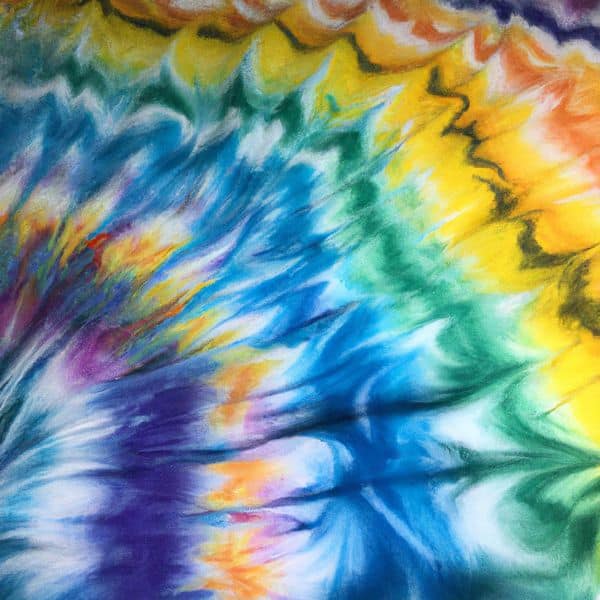Have you ever wondered if you can tie-dye polyester or spandex fabric? If yes, then this article is for you.
Tie-dyeing has been a popular DIY project for many years and it’s no surprise why. It adds color and personality to your clothes in a unique way that cannot be replicated by store-bought clothing.
Polyester and spandex fabrics are commonly used in sportswear due to their moisture-wicking properties and stretchability. However, these fabrics can be difficult to dye because they are synthetic fibers that don’t absorb dyes as easily as natural fibers like cotton or silk.
Keep reading to find out whether tie-dyeing polyester and spandex is possible, what materials you need, and how to do it correctly!
Can You Tie Dye Polyester And Spandex?
If you’re wondering if it’s possible to tie-dye polyester and spandex, the answer is yes!
While traditional tie-dye methods may not work as well on synthetic fabrics like these, there are special dyes made specifically for use on polyester and other synthetic materials.
These dyes typically require heat setting to ensure that the color sets properly.
Keep in mind that because of the nature of these fabrics, the dye may not take evenly or may not be as vibrant as it would be on natural fibers.
However, with some experimentation and patience, you can still achieve a unique tie-dye look on your favorite stretchy workout gear or polyester clothing items.
Can You Tie-Dye Polyester Blend?
Yes, tie-dyeing polyester and spandex is possible, but it may require a bit more effort than dyeing natural fibers. Polyester and spandex are synthetic materials that do not absorb color like natural fabrics do, so special care must be taken to ensure the dye adheres properly. To successfully dye polyester and spandex, you will need to use a type of dye called disperse dye which can bond with the fabric’s fibers. Additionally, it’s important to choose dyes specifically made for synthetic fabrics as they have higher heat requirements during the dyeing process.
Before beginning the dyeing process make sure your fabric is clean and free from any dirt or oils.
Use hot water when mixing the disperse dye in order to help dissolve the powder.
Follow instructions carefully regarding temperature control throughout the entire process and also consider using vinegar or salt for added adhesion benefits.
Overall, while tie-dyeing polyester blends can be challenging compared to other fabrics, it’s definitely achievable with patience and attention to detail. With proper preparation and execution of each step, you’ll be able to achieve vibrant colors without compromising on quality.
How To Dye 90% Polyester 10 Spandex
If you’re wondering how to dye 90% polyester and 10% spandex fabric, there are a few things to keep in mind. First off, it’s important to note that polyester is notoriously difficult to dye due to its synthetic fibers not absorbing color as well as natural fibers.
However, with the right materials and techniques, it can be done successfully. One option is to use a specialized polyester dye such as iDye Poly or Rit DyeMore Synthetic Fiber Dye which are designed specifically for this type of fabric. Another option is tie-dying using a kit made for polyester fabrics.
Be sure to follow the instructions carefully and use hot water when dying the fabric. The heat will help open up the fibers so they can absorb more color. It’s also recommended to prewash your polyester fabric before attempting to dye it in order to remove any dirt or oils that may interfere with the dyeing process.
With patience and attention to detail, you can achieve vibrant colors on your polyester/spandex blend without damaging the integrity of the fabric.

Can You Dye Spandex Fabric?
If you’re wondering whether you can dye spandex fabric, the answer is yes. However, it’s important to note that not all dyes are created equal, and some may work better on certain fabrics than others. When it comes to polyester and spandex blends, there are a few things to keep in mind.
First of all, tie-dyeing this type of fabric can be tricky since synthetic fibers don’t absorb dye as well as natural ones do. That being said, here are some tips for achieving the best results:
- Use a high-quality fabric dye specifically designed for synthetic materials.
- Pre-wash your garment in warm water and allow it to dry completely before beginning the dying process.
- Choose a lighter color dye if possible since darker colors tend to show up less vibrantly on synthetic fabrics.
- Consider using a hot water immersion method instead of traditional tie-dye techniques since this will help the dye penetrate more deeply into the fibers.
- Be patient and follow the instructions carefully – rushing or skipping steps could result in uneven coloring or damage to your garment.
Overall, while it may take a bit more effort to achieve vibrant colors when dyeing polyester and spandex blends compared with natural fibers like cotton or silk, it is definitely possible with the right tools and technique. So go ahead and get creative – just remember to test your chosen dye on a small area first before committing to the whole garment!
Can You Dye Spandex With Rit?
If you’re looking to add a pop of color to your spandex garments, you may wonder if Rit dye is the solution. While Rit can be used on various fabrics, it’s important to note that spandex is not one of them.
However, if you want to experiment with tie-dyeing polyester or a blend of polyester and spandex, go for it! Keep in mind that polyester fibers are resistant to dye absorption, so the colors may not turn out as vibrant as they would on natural fibers like cotton or silk.
It’s also essential to follow proper preparation steps before dyeing, such as washing the fabric without any fabric softener or detergent residue. Overall, while Rit isn’t suitable for dyeing spandex alone, there’s room for experimentation when it comes to tie-dying synthetic blends.
Can You Dye 98 Cotton 2 Spandex?
If you’re looking to add some color to your wardrobe, you may be wondering if it’s possible to dye polyester and spandex fabrics.
Unfortunately, tie-dyeing these materials can be difficult due to their synthetic nature. Polyester is a type of plastic fiber that doesn’t absorb dyes in the same way as natural fibers like cotton or wool. While there are specific types of dyes made for synthetics, they often require high heat and pressure to apply correctly, which could damage the delicate spandex fibers. Additionally, even with special dyes and methods, the colors may not turn out as vibrant or long-lasting on synthetic blends compared to natural ones.
That being said, if you’re interested in dyeing a fabric blend with spandex, 98% cotton and 2% spandex is likely your best bet. Cotton is a natural fiber that takes up dyes well, while the small percentage of spandex should still remain intact through the dyeing process. Just keep in mind that any added stretch might cause slight variations in how the dye appears on different parts of the garment.
Overall, while it may be tricky to achieve desired results when trying to dye polyester or spandex alone, experimenting with blended fabrics like cotton-spandex could yield better outcomes!
How To Dye Spandex
If you’re looking to add some color and life to your spandex garments, dyeing them is a great option. However, it’s important to note that not all dyes are suitable for spandex and polyester fabrics.
Here are three things you should keep in mind when attempting to dye spandex:
-
Choose the right type of dye: While some fabric dyes claim to work on all types of materials, it’s best to opt for a specific brand or variety that is safe for synthetic fibers like polyester and spandex.
-
Follow proper preparation techniques: Before dyeing your garment, make sure to thoroughly wash and dry it so that the fabric can absorb as much pigment as possible.
-
Be careful with temperature: Synthetic fabrics can be sensitive to heat, which can cause shrinkage or damage if exposed for too long. Make sure to use the appropriate water temperature as directed by your chosen dye product.
Remember that while it may take some trial and error, successfully dyeing polyester and spandex can result in beautifully vibrant clothing pieces that reflect your personal style!
Can You Dye 97% Cotton 3 Spandex
If you’re looking to add some colorful flair to your wardrobe, you may be wondering if tie-dyeing is possible on polyester and spandex garments. Unfortunately, the answer is no. These synthetic materials are not compatible with traditional dyes or tie-dye techniques due to their chemical makeup.
However, if you’re interested in dyeing natural materials like cotton that contain a small amount of spandex (such as 97% cotton and 3% spandex), it’s definitely doable! Just make sure to use fabric dye specifically designed for cotton blends and follow the instructions carefully to ensure optimal color absorption.
With a little patience and experimentation, you can create unique tie-dyed pieces that showcase both comfort and style without sacrificing material quality.
Conclusion
So, can you tie dye polyester and spandex? The answer is yes, but with some limitations. While it may be more challenging to achieve the desired results with these fabrics than with natural fibers like cotton or silk, it is still possible.
Now that you know it’s possible, the question is: will your attempt at tie-dyeing a polyester-spandex blend turn out as expected? Will the colors come out vibrant and beautiful, or will they fade quickly after one wash? It all depends on various factors such as fabric type, dye quality, water temperature, and time spent in the dye bath.
Only by trying it yourself can you discover whether this technique works for you. So go ahead and give it a shot – who knows what colorful creations await!
